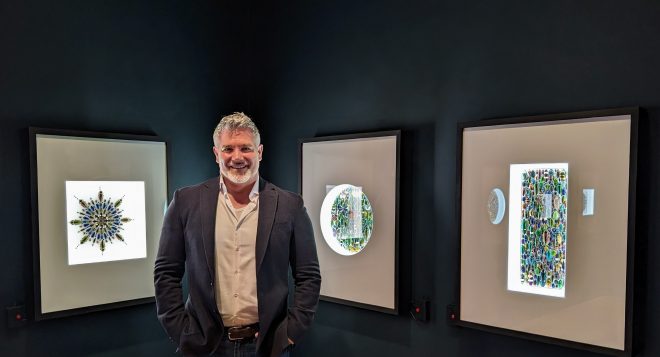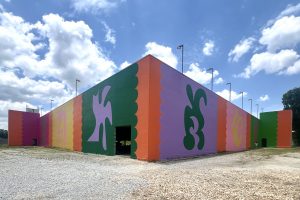“Exquisite Creatures” challenge art at Crystal Bridges

Artist and naturalist Christopher Marley pursued rare animals, reptiles and insects to the ends of the earth to create the new exhibit Exquisite Creatures at the Crystal Bridges Museum of American Art.
Thousands of preserved biological specimens, many arranged in complex, artful patterns, inhabit the multi-room exhibit which opened in March. The show intends to challenge the boundaries of science, nature and art.
The mind-boggling collection includes giant spiders, venomous reptiles, boa constrictors, and beautiful birds. Pretty little insects assembled into geometric mosaics are an important aspect of the show. Sea dragons – like large sea horses with flowing appendages, are mythically rare yet one is here. Frightening sea life includes a sharp-toothed eel and a colossal horseshoe crab.
Amazing insects abound, like the world’s largest beetle (Titanus Giganteus), as big as a football. An 18-inch walking-stick insect may be the largest bug in the world. Tiny sharks swim with a rainbow-hued iridescent lobster more than two-feet long. Fossils and skeletons. Rattlesnakes and vipers!
At a Crystal Bridges press preview, Marley barely managed to contain his enthusiasm. A strapping man, six feet tall with a graying beard and infectious grin, he bounded from display to display. He explained the specimens in affectionate detail like … well, like a guy showing off his best-ever bug collection.
Sort of a naturalist version of Indiana Jones, Marley has slogged through the backwaters of several dozen countries in his quests for rare and unusual specimens. Born in Covina near Los Angeles and raised in Oregon, he collected reptiles as a youth. At age 19, he became a missionary for two years in the Atacama desert region of Chile – one of the driest places on earth and notorious for weird flora and fauna.
Marley survived, graduating from Brigham Young University with a degree in graphic design. He became a model for Donna Karan and Armani. One day, joining colleagues on a fabric-hunting foray in Bangkok, he realized that collecting had been his true passion all along.
Marley’s design aesthetic distinguishes his work from other naturalists, elevating it to a level for display in an art museum. The exhibit goes way beyond bugs on pins in a dusty display case or animal skulls in a dim corner of a natural-history museum. Exquisite Creatures is more fantastic, more fanciful.
Marley’s work is said to differ from traditional taxidermy because he often preserves the entire organism, not just the skin. He uses a freeze-drying process to capture natural textures and colors. He said he retouches some with “smidgeons of color,” but he attempts to remain true to life. Plenty of clear-coat, which can be another effective preservative, seems to have been used, though some specimens like beetles are naturally glossy.
Marley says that he avoids capturing and killing live specimens. He draws on a network of museums, university biologists, fishing companies and adventurers that help gather specimens, some of which have died naturally in the wild.
Artfully arranged insects are the show’s stars. Marley uses them like tiles to build geometric patterns in intricate and sometimes startling ways. He arranges shiny beetles and ladybugs in floral patterns. He groups butterflies like a skillfully fanned deck of playing cards.
Marley’s exhibit relates to the concept of biophilia (literally: love of life). The idea that humans have an innate affinity for nature dates back to Aristotle; however, biologist Edward O. Wilson popularized the hypothesis in his 1984 book Biophilia. He defined biophilia as “the urge to affiliate with other forms of life.”
Biophilia also happens to be the title of Marley’s second book, published in 2015, but it’s more of a coffee-table volume compared to Wilson’s philosophical treatise. Another book by Marley, Exquisite Creatures: A Dialogue with Art, Nature, and Science (2023) serves as a guide to the current show.
In an interview, Marley explained how the later book’s subtitle sums up his method. The specimens represent nature and science while art is the human element. “Imagine science, nature and art as three overlapping circles,” he said. “I’m trying to capture the special place in the center, where nature and science intersect with human intuition – with learning, creativity and beauty.”
Maybe you will never get lost without drinking water for three days on the Amazon, like Christopher Marley did, or encounter a ragtag band of Sendero Luminoso guerillas in a Peruvian jungle.
Even at age 55, Marley has a way of making everything seem easy and fun. He brings a childlike enthusiasm and energy into a room. That would also be a fine way for visitors to approach his museum show.
Almost anyone will enjoy Exquisite Creatures because it’s engaging, beautiful and exciting. And the show should have special appeal for young people, and for families seeking a group activity. It could stimulate discussions in this age of screen addiction, or even inspire kids to seek a science career.
Still, some of the exhibits can feel like a science lesson when they compare two dozen varieties of the same lizard or beetle. And some of these exquisite creatures can be frightening even in death – vicious, poisonous or even grotesque such as the birds splayed, almost spatchcock-style, on mounting boards.
Exquisite Creatures is a rare opportunity to see marvelous biological specimens, respectfully preserved and vividly presented, in a way that challenges the boundaries of art more than science or nature — but brings them all together spectacularly.
Exquisite Creatures will be at Crystal Bridges through July 29. It will then move to a yearlong run at the Oregon Museum of Science and Industry in Portland.
This article originally appeared in the New Haven Independent/Review Crew.





Comments